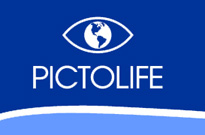|
Chondrilla nucula |
Distribution |
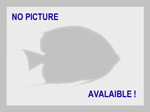
|

|
Chicken liver sponge;White encrusting sponge |

|
Weisser Krustenschwamm |

|
Witte korstspons |

|
Eponge encroûtante blanche, Chondrille |

|
Esponja blanca incrustante |

|
|
|
The tropical Atlantic
The tropical Pacific
The Red Sea
The Indian Ocean
The Mediterranean |
|
Surrounding and environment |
|
The species develops on the reef
The species is found in a sheltered zone
The species can be found between 1 and 700 Meters
Common species.
|
|
General characteristics of the species |
|
Diameter of the animal : 10 cm
The form is encrusting
The surface looks smooth
The animal can show variable colouring
|
|
Relationship with humans |
The species is exploited in the following sector(s) :
- Chemistry/pharmacy.
|
|
Haliclona viscosa |
Distribution |

|

|
Purple volcano sponge |

|
Rosa Zylinderschwamm |

|
Roze schoorrnsteenspons |

|
Chaline à cheminées roses |

|
Esponja de chimenea rosada |

|
|
|
The temperate Atlantic
The Mediterranean |
|
Surrounding and environment |
|
The species develops on the reef
The species is found in a sheltered zone
The species can be found between 0 and 50 Meters
Uncommon Species
|
|
General characteristics of the species |
|
Diameter of the animal : 30 cm
Height of the animal : 5 cm
The shape is tubular
The surface looks rough
The animal can show variable colouring
|
|
Relationship with humans |
The species is exploited in the following sector(s) :
- Chemistry/pharmacy.
|
|
The species can be confused with other species of similar appearance! |
|
Xestospongia testudinaria |
Distribution |

|

|
Barrel-sponge |

|
Großer Vasenschwamm |

|
Tonspons |

|
Eponge-barrique |

|
Esponja barril |

|
Spugna barile del Mar Rosso |
|
The tropical Pacific
The Red Sea
The Indian Ocean |
|
Surrounding and environment |
|
The species develops on the reef
The species can be found between 0 and 50 Meters
Uncommon Species
|
|
General characteristics of the species |
|
Diameter of the animal : 200 cm
Height of the animal : 200 cm
The animal is vase-shaped
The surface looks rough
The animal can show variable colouring
|
|
Relationship with humans |
The species is exploited in the following sector(s) :
- Chemistry/pharmacy.
Used in the clothing, footwear or crafts industries for the manufacture of articles (jewellery, etc.).
|
|
The species can be confused with other species of similar appearance! |
|
Axinella verrucosa |
Distribution |

|

|
Mediterranean mermaids glove |

|
Lamellengeweihschwamm |

|
|

|
Axinelle verruqueuse |

|
Esponja verrugosa |

|
Spugna verrucosa |
|
The temperate Atlantic
The Mediterranean |
|
Surrounding and environment |
|
The species develops on the reef
The species can be found between 10 and 75 Meters
Uncommon Species
|
|
General characteristics of the species |
|
Height of the animal : 15 cm
The animal is branch-shaped
The surface looks smooth
|
|
Relationship with humans |
The species is exploited in the following sector(s) :
- Chemistry/pharmacy.
|
|
The species can be confused with other species of similar appearance! |
|
Ircinia fasciculata |
Distribution |
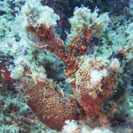
|

|
Stinker Sponge |

|
Krustenlederschwamm |

|
korstvormige lederspons |

|
Ircinia fibreuse |

|
Esponja catedral |

|
|
|
The temperate Atlantic
The Mediterranean |
|
Surrounding and environment |
|
The species develops on the reef
The species is found in a sheltered zone
The species can be found between 1 and 70 Meters
Uncommon Species
|
|
General characteristics of the species |
|
Diameter of the animal : 30 cm
The animal is in the form of a mass
The surface looks rough
The animal can show variable colouring
|
|
Relationship with humans |
The species is exploited in the following sector(s) :
- Chemistry/pharmacy.
|
|
The species can be confused with other species of similar appearance! |
|
Rhabdastrella globostellata |
Distribution |

|

|
Yellow pot sponge |

|
|

|
|

|
Eponge massive stellaire |

|
|

|
|
|
The tropical Pacific
The Indian Ocean |
|
Surrounding and environment |
|
The species develops on the reef
The species can be found between 1 and 35 Meters
Common species.
|
|
General characteristics of the species |
|
Diameter of the animal : 30 cm
The animal is in the form of a mass
The surface looks rough
|
|
Relationship with humans |
The species is exploited in the following sector(s) :
- Chemistry/pharmacy.
|
|
The species can be confused with other species of similar appearance! |
|
Spongia officinalis |
Distribution |
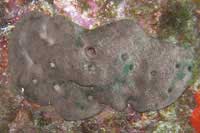
|

|
Bath sponge |

|
Badeschwamm |

|
Badspons |

|
Eponge de toilette |

|
Esponja de baño |

|
Spugna da bagno |
|
The Mediterranean |
|
Surrounding and environment |
|
The species develops on the reef
The species can be found between 5 and 75 Meters
Uncommon Species
Endemic species.
|
|
General characteristics of the species |
|
The animal is in the form of a mass
The surface looks rough
The animal can show variable colouring
|
|
Relationship with humans |
The species is exploited in the following sector(s) :
Used in the clothing, footwear or crafts industries for the manufacture of articles (jewellery, etc.).
|
|
The species can be confused with other species of similar appearance! |
|
Spongia agaricina |
Distribution |
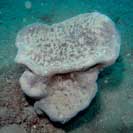
|

|
Elephant ear |

|
Elephantenohr-Schwamm |

|
Olifantenoor spons |

|
Oreille d'éléphant |

|
Oreja de elefante |

|
Orecchie d?elefante |
|
The temperate Atlantic
The Mediterranean |
|
Surrounding and environment |
|
The species develops on the reef
The species can be found between 5 and 120 Meters
Common species.
|
|
General characteristics of the species |
|
Diameter of the animal : 100 cm
The animal is in the form of a mass
The surface looks smooth
The animal can show variable colouring
|
|
Relationship with humans |
The species is exploited in the following sector(s) :
Used in the clothing, footwear or crafts industries for the manufacture of articles (jewellery, etc.).
|
|
The species can be confused with other species of similar appearance! |
|
Suberites ficus (domuncula) |
Distribution |
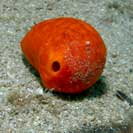
|

|
Sulphur sponge ; hermit sponge |

|
Einsiedler-Korkschwamm ; Feigenschwamm |

|
Vijgspons |

|
Orange de mer ; Subérite figue |

|
Esponja del ermitaño |

|
Spugna del paguro |
|
The tropical Atlantic
The temperate Atlantic
The Mediterranean |
|
Surrounding and environment |
|
The species develops on the reef
The species can be found between 1 and 1000 Meters
Uncommon Species
|
|
General characteristics of the species |
|
Diameter of the animal : 40 cm
The animal is in the form of a mass
The surface looks smooth
The animal can show variable colouring
|
|
Relationship with humans |
The species is exploited in the following sector(s) :
- Chemistry/pharmacy.
|
